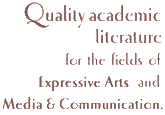Reviews Under Construction
Please come again soon.
Explore "Minstrels of Soul"
From The Arts in Psychotherapy, Vol. 23, No. 3, pp 275-276, 1996
Copyright @1996 Elsevier Science, Ltd.
Minstrels of Soul: Intermodal Expressive Therapy
Paolo J. Knill, PhD, Helen Neinhaus Barba, MA, A.T.R., and Margo N. Fuchs, PhD
(Toronto, Canada: Palmerston Press, 1995, 182 Pages, $19.95 US, paperback)
This small book attempts much—and partially succeeds. It is likely to be received with enthusiasm by those who embrace the field of expressive therapy (a prediction supported by the endorsements on the books’ cover) and with a certain sense of frustration by those from other disciplineswho are hoping to gain a deeper understanding of this multi-disciplinary approach. And to lay my cards on the table—or my paint on the palette—as an art therapist working with visual media, I count myself among the latter. Nonetheless, I think the book is worthy of general attention. There is little in print that presents the case for the integrated application of the arts therapies. There is even less that strives to ground this approach in aesthetic theory and the arts traditions.
However, a closer look will assist in evaluating the merits and demerits of this work. An updated and expanded version of an earlier text by the first author (Knill, 1979), the book is intended to be more evocative than explicit. Poetic fragments introduce each of the first five major sections and appeat at other junctures throughout the text. Part One reviews the historical use of the arts in healing and presents some basic concepts. In the process, the interrelation of the arts is stressed. It is emphasized that rituals over the ages have blended the individual arts rather than employing them in isolation. Further, it is pointed out that each art form encompasses more than one sense modality (e.g., both the visual and the sensorimotor modalities are involved in the process of painting and drawing). This common ground invites the conclusion that intermodal transfer—that is, moving from one art discipline to another—is not as daunting as might first appear.
Part Two examines three aspects of psychic reality that are considered important to an understanding of the philosophy underlying expressive therapy. The writing here seems unnecessarily opaque. Although the definitions of imaginal and literal reality seem relatively obvious, effective reality is difficult to comprehend. It appears to refer to the meaning that emerges from an interplay between a person’s mental imagery and the real world. However, statements such as the following tend to confuse rather than clarify this concept. “Effective reality is created through being in the world. It is in fact the soul of being. It is what makes us feel. In our effective realities, the world comes forth in our opening” (p. 64).
Part three focuses on the healing essence of the arts and, in this regard, explores aesthetics, Eros and aggression. It, too, is difficult going, but it also presents some of the book’s more interesting ideas. Most especially, the emphasis on beauty as a criterion of expressive therapy is thought-provoking, particularly when viewed in conjunction with love and destruction and their relationship to the creative process. This is not the theory of sublimation in new dress, but an attempt at something grander: forging an association with a universal creative urge that goes beyond in the individual’s defensive motivations.
Part Four addresses applications of intermodal expressive therapy and Part Five presents some thoughts concerning directions for further research. These sections are more concrete than the others and bring some welcome clarity to the practice of expressive therapy. Part Four is particularly illuminating. Here, the technique of dialoguing with the image is elaborated. Here, too, the essentially “art as therapy” nature of expressive therapy is underscored. This emphasis is conveyed through several interesting examples of intermodal techniquesas well as through explicit statements. “In viewing therapy as an artistic process, we find the process itself (not the processing) offers by far the most significant theraputic value” (p. 140).
As I have indicated, some parts of this book are more accessible than others. Perhaps this stems from an underlying assumption. In his Forward, Shaun McNiff states, “The Core method of expressive therapy practice [is] something distinctly present yet outside the scope of explaining” (p. 11). Enthrallment with mystery can be used to justify a certain fuzziness of thought. Granted there is much we currently do not understand about art and aesthetics; however, there is reason to believe that this will not always be the case. For example, research in evolutionary psychology has found evidence for a genetic component in aesthetic preferences for certain landscapes (Orians & Heerwagen, 1992). Indeed, this research suggests that our fascination with mystery—or the explanatory urge—may itself be biologically determined.
A second drawback concerns the work’s philosophical underpinning. This appears to consist of a mixture of phenomenological and archetypical theories that verges on the mystical. Further, there seems to be a presumption that the reader will share this philosophy. But not all arts therapists accept the validity of such statements as “The image dwells in the world independently from all of us and visits us in the presentation” (p. 89). Surely expressive therapy can be approached from other perspectives. The text would be stronger—and more compelling—if at least some of these were acknowledged.
Finally, there is the problem of acquiring interdisciplinary skills. In their Introduction, the authors state:
We agree that it may help for an expressive therapist to build upon one or more
basic disciplines and that training cannot consist of a mere conglomeration of arts
therapies. Above all, however, we are advocating for a specialization in the
interdisciplinary tradition of the arts. (p. 17)
It is far from clear, though, how such interdisciplinary training is accomplished. Imagine, for example, a visual art therapist (or a client) with a tin ear and two left feet. Obviously, there are personal limitationsthat rule out a career (or satisfactory participation) in expressive therapy. This, in turn, points up a need for a rationale that encompasses all the arts therapies—practiced either singly or in combination. I am not suggesting that the authors should have taken on this formidable task, but simply that in advocating for an integration of the arts, they might have given more consideration to the complex reasons that have led to separate disciplines.
Still, I recommend this work. It offers readers an introduction to one of the newest members of the family of arts therapies. It also emphasizes the importance of including a deeper understanding of aesthetics—the heart of art—in our respective creative disciplines. Both through what is addressed and what is not, it reminds us that there are many relevant questions yet unanswered. Taking inspiration from one of the book’s poetic musings, we must continue
“Ordering the disorder
and disordering the order
until it organizes itself” (p. 76).
Francis F. Kaplan, DA, A.T.R.-BC
Book Review Editor
References
Knill, P. (1979). Ausdruckstherapie. Lilienthal, Germany: ERES. Oriens, G.H., & Heerwagen, J.H. (1992). Evolved responses to landscapes. In J. H. Barkow, L. Cosmides, & J. Tooby (Eds.), The Adapted Mind: Evolutionary psychology and the generation of culture (pp. 555-579). New York: Oxford University Press.
order details ...

